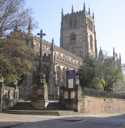 Nottingham Nottingham
St Mary
Stonework
Local Triassic sandstone (Sneinton Formation, Mercia Mudstone Group) probably
from the Sneinton or Gedling quarries – a fine grained yellow-brown
sandstone – is found in many of the older parts of the building. It is
notable in the tower and is clear in the original window mouldings when viewed
from the roof access. It is a soft stone, cross-bedded with mudstone clasts,
and does not weather well. It has commonly been replaced by a variety of other
sandstones. The carved heads on the south nave wall seemed to be a mixture
of this original sandstone and some re-carved replacements.
A number of the stones
in the church have interesting
marks inscribed on them.
There is a notable amount of replacement with other Triassic sandstones from
Hollington Quarries (still operating) and Alton Stone (Townhead Quarry). These
quarries are not far apart and effectively working the same beds (Triassis,
Sherwood Sandstone Group). The stones are similar, ranging from an off-white
variety to red and creamy coloured varieties. Other replacement stones include
hard pale grey Carboniferous sandstones, probably from the Ashover Grit of
the Matlock area of Derbyshire. One of the principal suppliers of stone into
the city in the 19th Century was the Stancliffe
Darley Dale Quarry, but other sandstone quarries operated nearby and the stone
from these is largely indistinguishable from the Darley Dale stone. Some window
mouldings on the south side of the church (Lady Chapel) do appear to be partly
replaced with coarsely crystalline orange-brown Bulwell Stone (Permian, Lower
Magnesian Limestone-now known as Cadeby Formation).
In the Chancel and Sanctuary the coarsely grained fossil floor stone is a
crinoidal limestone known as Derby Fossil. The green floor marble with white
veining is probably French Campan Vert from the Pyrenees.
| 




